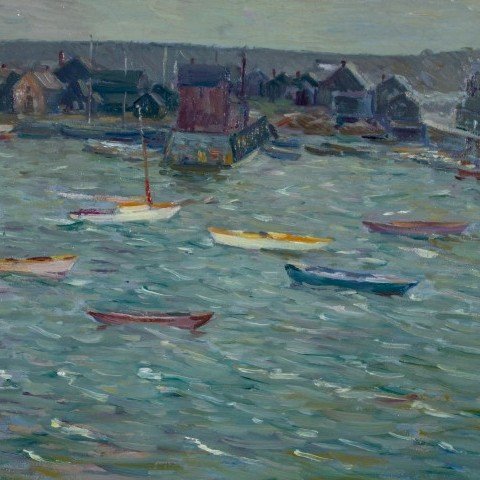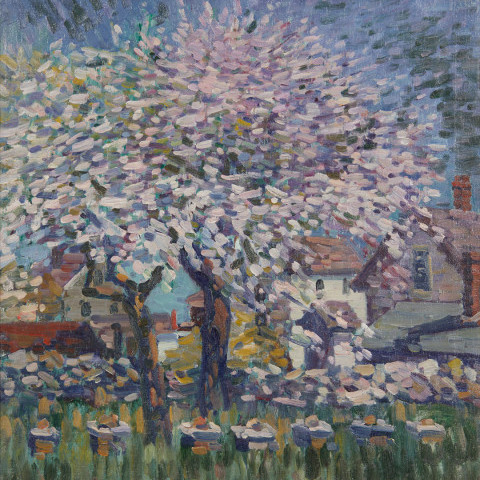Described as an artist whose "love of nature amounted to a passion," Charles Salis Kaelin was one of the earliest American exponents of Divisionism. A respected member of the art colony at Rockport, Massachusetts, Kaelin's colorful renderings of Cape Ann scenery were championed by many of his fellow artists, including Frank Duveneck, one of the first to recognize the high quality and innovative nature of his work.
Kaelin was born in Cincinnati in 1858, the son of a Swiss lithographer. Following in his father's footsteps, he entered a local lithographic firm at the age of sixteen. In the fall of 1877, he enrolled in evening classes at the McMicken School of Design (later known as the Art Academy of Cincinnati), where he was taught by Thomas Satterwhite Noble. During the summer or fall of 1878 Kaelin supplemented his studies at the McMicken by taking additional instruction from John Henry Twachtman, who had just returned to Cincinnati after sojourns in Munich and Venice. Not surprisingly, Twachtman's emphasis on landscape themes and his sketchy, Munich-inspired style appealed to Kaelin's own penchant for nature and subjective expression, much more so than Noble's preoccupation with academic portraiture and genre themes.
Kaelin traveled to New York City in 1879, enrolling in classes at the Art Students League. He continued to live there throughout the 1880s and early 1890s, working as a lithographer and painting during his spare time. Returning to Cincinnati in 1892, he joined the prestigious Strobridge Lithographic Company, as a designer of theater posters, calendars and other forms of advertising art. In the years ahead, he took many sketching trips throughout southern Ohio and Kentucky. Working exclusively in pastel, a medium in which he excelled, he portrayed the countryside in a delicate, poetic manner, reminiscent of Twachtman. His earliest critical recognition came in 1899, when the Cincinnati Art Museum organized an important solo exhibition devoted exclusively to his pastels.
At the urging of his friend and fellow artist, Frank Duveneck, Kaelin made his first trip to Gloucester, Massachusetts, in the summer of 1900. Inspired by the clear, brilliant light of the region, as well as by the rugged coastlines and pine forests that typified the area, Kaelin continued to make seasonal visits to the North Shore for well over a decade. After coming into contact with several of the American Impressionists who painted in Gloucester, such as Twachtman, Theodore Wendel, and Childe Hassam, he abandoned his earlier, tonal manner and took a greater interest in light and color. At the same time, he also began to employ a divisionist technique, associated with European Post-Impressionism, in which long, emphatic strokes of crayon were tightly woven together to create an overall tapestry of line and color. Contemporary critics spoke frequently of the "daring" and "experimental" nature of his work.
In 1916, Kaelin relinquished his lucrative career as a lithographer and settled permanently in Rockport, the smaller of the two principal towns on Cape Ann. In the years ahead, he spent his time rendering the sun-dappled harbor and the nearby woodland forests, working in both pastel and oil.
Although his desire for solitude often led to his being referred to as the "hermit painter," Kaelin's name was consistently linked with art activity in the Midwest and in the Northeast. In Cincinnati, his work was frequently displayed at the annual exhibitions of the Cincinnati Art Museum, the Society of Western Artists, and the Duveneck Society of Painters and Sculptors. He also had important one-man exhibitions in Cincinnati (1913, 1920), Saint Louis (1909), and Buffalo (1920). In 1915, he was awarded a silver medal at the Panama-Pacific Exposition for his pastels. Following his move to Rockport, Kaelin's work was exhibited at the Gallery-on-the-Moors in Gloucester, the Boston Art Club, and the Pennsylvania Academy of the Fine Arts in Philadelphia. He was also a founding member of the Rockport Art Association (1921). In 1930, a year after his death, Kaelin's numerous friends and admirers organized an important memorial exhibition of his work for Traxel's Galleries in Cincinnati.
Examples of Charles Kaelin's work can be found in many public and private collections, including the Metropolitan Museum of Art, New York; the Butler Institute of American Art, Youngstown, Ohio; the Cincinnati Art Museum; the Cape Ann Art Association, Gloucester; the Rockport Art Association; the Achenbach Foundation for Graphic Arts, Fine Arts Museums of San Francisco; and ITT Corporation, New York.
source: askart.com, Spanierman Gallery, LLC


